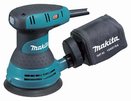How to Replace the Pad on a Random Orbital Sander
 Replacing the pad on a random orbital sander is one of the most common maintenance procedures found in the power tool industry. Fortunately for woodworkers and tool users, it is also one of the very simplest tasks your power tools will every as you to perform. In fact, replacing your sander’s backer pad requires little more than, well, removing one, installing the other, and slapping a few screws around in between.
Replacing the pad on a random orbital sander is one of the most common maintenance procedures found in the power tool industry. Fortunately for woodworkers and tool users, it is also one of the very simplest tasks your power tools will every as you to perform. In fact, replacing your sander’s backer pad requires little more than, well, removing one, installing the other, and slapping a few screws around in between.
To cut straight to the chase, the first step in any repair or maintenance procedure is to disengage and unplug your sander. All power tools and working machines should be entirely off before you begin working on them.

 Additionally, because not all sanding pads are the same (the consistency of the pads and number of their dust-collection and screw holes vary from pad to pad), the first step in replacing this item on your sander is ensuring you have the right backer pad (from the right manufacturer) for the procedure at-hand. To do this, all you need is the model number of your tool and one of the following few things: access to the tool’s schematic and parts list, access to a tools/parts/service rep at your preferred tool parts dealer, or access to the internet. Any of these avenues will set you on the right path to finding the exact part number for the exact pad you need. Simply share your tool’s model number, and the item you need for it should follow suite.
Additionally, because not all sanding pads are the same (the consistency of the pads and number of their dust-collection and screw holes vary from pad to pad), the first step in replacing this item on your sander is ensuring you have the right backer pad (from the right manufacturer) for the procedure at-hand. To do this, all you need is the model number of your tool and one of the following few things: access to the tool’s schematic and parts list, access to a tools/parts/service rep at your preferred tool parts dealer, or access to the internet. Any of these avenues will set you on the right path to finding the exact part number for the exact pad you need. Simply share your tool’s model number, and the item you need for it should follow suite.
Once you have procured the correct pad for your specific sander, you can get into the meat of the procedure. First, remove all mounting screws from the existing backer pad (there should be either three or four screw-holes, the other holes (either five or eight) will be for dust collection). Remove and discard the old pad. Place the new backer pad on the sander matching the screw-holes in the pad to those on the sander. Insert and slightly tighten-down each screw. Again, leave each screw slightly loose until all screws have been inserted and half-tightened. Once all mounting screws are in place, tighten them firmly.
HINT: Some folks find it simpler to insert the mounting screws into the screw-holes on the new pad before matching them to the holes on the sander. This allows the screws to guide themselves into place. Using this method, it is still important to half-tighten each screw before fully tightening any of them.
And at that, you have successfully replaced the backer pad on your random orbital sander. Engage the power tool, giver the sander a quick spin to ensure the pad stays put, and consider the thing now in fine fighting form.













